I am losing my mind over this.
I am trying to design a Deliyannis-Friend section and I am stuck in a loop and don't know what to do. These is the circuit and its equations.
Based on this I have devised a design method.
The design starts by setting equal capacitors, \$ C_1 = C_2 = C \$, and choosing the value of capacitance \$ C \$. Taking the expression of \$ K_p \$ and \$ Q \$, results in
\begin{equation} \frac{|K_p|}{Q} = \frac{ \displaystyle 1+\frac{R_f}{R_g}}{ \displaystyle \sqrt{\frac{R_1}{R_2}}} \,, \label{eq:DFderiv1} \end{equation}
By choosing the ratio \$ \displaystyle \beta = \frac{R_2}{R_1} \$, the ratio \$ \displaystyle \alpha = \frac{R_f}{R_g} \$ comes as
\begin{equation} \alpha = \frac{|K_p|}{Q} \times \frac{1}{\displaystyle \sqrt{\beta}} -1 \,, \label{eq:DFderiv2} \end{equation}
which leads to the design constraint
\begin{equation} 0 < \beta < \left(\frac{|K_p|}{Q}\right)^2 \,. \label{eq:DFderiv3} \end{equation}
Now, from the chosen ratio \$ \beta \$, resistors \$ R_1 \$ and \$ R_2 \$ can be calculated as
\begin{equation} R_1= \frac{1}{\omega_p \times C} \times \frac{1}{\sqrt{\beta}} \,, \label{eq:DFderiv4} \end{equation}
and
\begin{equation} R_2= \frac{\sqrt{\beta}}{\omega_p \times C} \,. \label{eq:DFderiv5} \end{equation}
Finally, with \$ \alpha \$ and choosing \$R_g\$,
\begin{equation} R_f= \alpha \times R_g \,. \label{eq:DFderiv6} \end{equation}
Ok, into a practical design with \$ K_p = - 0.5 \$ and \$ Q = 5 \$ and \$ \omega_p = 10000 \$
I choose \$ C = 10 \, \text{nF} \$. As \$ 0 < \beta < 0.01 \$ I choose the middle value \$ \beta = 0.005 \$ This allows as to obtain \$ R_1 = 141.42 \, \text{k$\Omega$} \$ and \$ R_2 = 707.11 \, \text{$\Omega$} \$
Plugging this into the \$ \omega_p \$ expression does allow to obtain the \$ \omega_p \$ value of \$ 10000 \$. So until this point we are keeping our sanity.
Now comes \$ \alpha \$. It is equal to \$ \alpha = -1 + \sqrt{2} \$. So choosing \$ R_g = 141.42 \, \text{k$\Omega$} \$ follows that \$ R_f = 58.578 \, \text{k$\Omega$} \$.
And now plugging these values in the gain and Q expressions gives \$ Q = 22.4 \$ and \$ K_p = -0.0035 \$
What is actually going on here? Where was my mistake? Did I accidentally divide by zero or something? Forgot a sign? I am losing my mind I swear...
UPDATE MAY 20
Ok, so a new attempt. I have decided to actually redefine \$ \alpha \$ as \$ \displaystyle 1 + \frac{R_f}{R_g} \$
So here are the three equations I have
$$ K_p = - \frac{\alpha}{\frac{2}{\beta}- \left(\alpha - 1\right)} $$
$$\frac{1}{Q} = \frac{2}{\sqrt{\beta}} - (\alpha -1) \sqrt{\beta}$$
$$\frac{K_p}{Q} = - \alpha \sqrt{\beta} $$
So replacing the third equation on the second allows to obtain
$$ \frac{1}{Q} = \frac{2}{\sqrt{\beta}} + \frac{K_p}{Q} + \sqrt{\beta} $$
Solving for \$ \sqrt{\beta} \$ gives two solutions:
$$\beta_1 = \left( \frac{1-K_p}{2Q} \times \left( 1 + \sqrt{1 - \frac{8Q^2}{(1-K_p)^2}} \right) \right)^2$$
$$\beta_2 = \left( \frac{1-K_p}{2Q} \times \left( 1 - \sqrt{1 - \frac{8Q^2}{(1-K_p)^2}} \right) \right)^2$$
and \$ \alpha \$ can be calculated with
$$\alpha = -\frac{K_p}{Q \sqrt{\beta}} $$
I have tried to solve this using Mathematica
Clear[Kp, Q]
condbeta1 = (1 - Kp)/(2*Q)*(1 + Sqrt[1 - (8 Q^2)/(1 - Kp)^2]);
condalpha1 = -Kp/Q*1/condbeta1;
condbeta2 = (1 - Kp)/(2*Q)*(1 - Sqrt[1 - (8 Q^2)/(1 - Kp)^2]);
condalpha2 = -Kp/Q*1/condbeta2;
Reduce[condbeta1 > 0 && condalpha1 > 1 && Q > 0 && Kp < 0, Kp]
Reduce[condbeta2 > 0 && condalpha2 > 1 && Q > 0 && Kp < 0, Kp]
My logic was that:
- \$ \sqrt{\beta_1} \$ and \$ \sqrt{\beta_2} \$ should be positive numbers. When I did this manually I have arrived with the condition that @Tesla23 arrived: \$ K_p < 1 - \sqrt{8} Q \$.
- The second condition is that \$ \alpha \$ should be bigger than 1.
- Additionaly the quality factor Q shall be positive and the gain Kp shall be negative.
This allows to obtain
- The first solution is only valid for \$ Q>\frac{1}{\sqrt{2}} \$ in which case \$ -2Q^2 < K_p \leq 1 - 2\sqrt{2}Q\$
- As for the second solution, it is valid for \$ 0 < Q \leq \frac{1}{\sqrt{2}} \$ in which case \$ K_p < -2Q^2 \$ or for \$ Q > \frac{1}{\sqrt{2}} \$ in which case \$ K_p < 1 - 2\sqrt{2}Q\$.
This seems to solve the problem.
